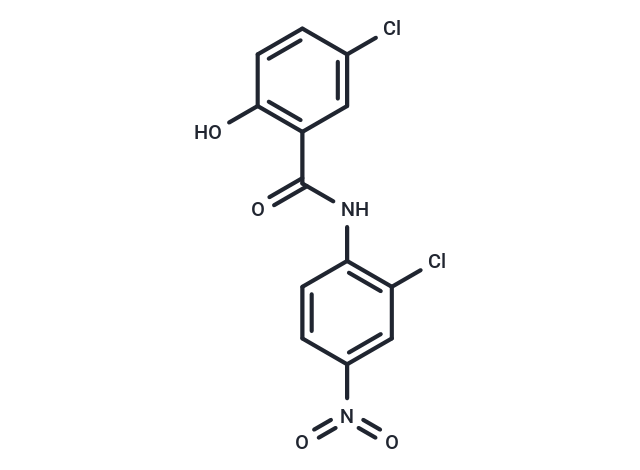Shopping Cart
- Remove All
 Your shopping cart is currently empty
Your shopping cart is currently empty

Niclosamide (Niclocide)(BAY2353) is used to treat most tapeworm infections by inhibiting DNA replication.

| Pack Size | Price | Availability | Quantity |
|---|---|---|---|
| 500 mg | $39 | In Stock | |
| 5 g | $47 | In Stock | |
| 1 mL x 10 mM (in DMSO) | $43 | In Stock |
| Description | Niclosamide (Niclocide)(BAY2353) is used to treat most tapeworm infections by inhibiting DNA replication. |
| Targets&IC50 | STAT3:0.7 μM |
| In vitro | Niclosamide (< 5 μM) dose dependently inhibits STAT3-mediated luciferase reporter activity with IC50 of 0.25 μM in HeLa cells. Niclosamide(< 2 μM) dose dependently inhibits the phosphorylation of STAT3 in Du145 cells. Niclosamide (1 μM) inhibits the EGF-induced nuclear translocation of STAT3 in Du145 cells. Niclosamide(< 2 μM) dose dependently inhibits the transcription of STAT3 downstream genes in Du145 cells. Niclosamide(< 10 μM) dose dependently induces G0/G1 arrest and apoptosis of Du145 cancer cells. [1] Niclosamide is able to inhibit SARS-CoV replication at a micromolar concentration in Vero E6 cells infected with SARS-CoV. [2] Niclosamide(< 7.5 μM) promotes Frizzled1 endocytosis, downregulates Dishevelled-2 protein, and inhibits Wnt3A-stimulated beta-catenin stabilization and LEF/TCF reporter activity in U2OS cells. [3] Niclosamide inhibits the TNF-induced NF-κB reporter activity in a dose- and time-dependent manner in U2OS cells. Niclosamide(125 nM) inhibits NF-κB activation induced by p65, IKKα, IKKβ, IKKγ, and TAK1 in U2OS cells. Niclosamide(< 500 nM) completely block the time- and dose-dependent TNFα-induced alteration of the NF-κB–DNA complex in HL-60 cells. Niclosamide(< 10 nM) inhibits constitutive NF-κB activation in U266 cells. Niclosamide inhibits TNF-induced degradation of IκBα and relocation of p65 in a dose- and time-dependent manner in HL-60, Molm13, or AML primary cells. Niclosamide(500 nM) decreases TNF-induced NF-κB–dependent gene products involved in cell survival in HL-60 cells. Niclosamide dose dependently inhibits the growth and induces robust apoptosis of AML cells associated with decreased Mcl-1 and XIAP levels and increased intracellular ROS levels. [4] |
| In vivo | Niclosamide(40 mg/kg/d, i.p.) inhibits growth of xenografted AML cells in nude mice bearing HL-60 xenograft tumors. [4] |
| Kinase Assay | Protein Kinase profiling assay: Assay for 22 different proteins kinases is carried out by ProQinase Gmbh. All of the protein kinases are expressed either in Sf9 insect cells or in E.coli as recombinant GST-fusion proteins or His-tagged proteins. Protein kinases are purified by affinity chromatography using either GSH-agarose or Ni_NTH-agarose. A radiometric protein kinase assay is used for measuring the kinase activity of the 22 protein kinases. Briefly, for each protein kinase, 50 μL reaction cocktail containing 60 mM HEPES-NaOH, 3 mM MgCl2, 3 mM MnCl2, 3 μM Na-orthovanadate, 1.2 mM DTT, 50 μg/mL PEG20000, 1 μM [γ-33P]-ATP, Niclosamide, adequate amount of enzyme and its substrate. The PKC-alpha assay additionally contain 1 mM Cacl2, 4 mM EDTA, 5 μg/mL phosphatidylserine and 1 μg/mL 1, 2-Dioleyl-glycerol. The reaction cocktails are incubated at 37 °C for 60 minutes and stop with 50 μL 2% (v/v) H3PO4. Incorporation of 33Pi is determined with a microplate scintillation counter. The activities and the IC50 values are calculated using Quattro Workflow V2.28. |
| Cell Research | Cells are plated in 96-well culture plates with cell density of 3-4 × 103 cells/well and treat with Niclosamide by adding 100 μL medium containing Niclosamide of various concentrations on the second day. After 72-hour's treatment, MTT is added to each well and incubated for additional 4-5 hours, and the absorbance is measured on a microplate reader at 570 nM. Cell growth inhibition is evaluated as the ratio of the absorbance of the sample to that of the control. The results are representative of at least 3 independent experiments. (Only for Reference) |
| Alias | Niclocide, BAY2353 |
| Molecular Weight | 327.12 |
| Formula | C13H8Cl2N2O4 |
| Cas No. | 50-65-7 |
| Smiles | C(NC1=C(Cl)C=C(N(=O)=O)C=C1)(=O)C2=C(O)C=CC(Cl)=C2 |
| Relative Density. | 1.6646 g/cm3 (Estimated) |
| Storage | keep away from moisture | Powder: -20°C for 3 years | In solvent: -80°C for 1 year | Shipping with blue ice. | |||||||||||||||
| Solubility Information | 10% DMSO+40% PEG300+5% Tween 80+45% Saline: 0.63 mg/mL (1.93 mM), In vivo: Please add the solvents sequentially, clarifying the solution as much as possible before adding the next one. Dissolve by heating and/or sonication if necessary. Working solution is recommended to be prepared and used immediately. DMSO: 6.25 mg/mL (19.11 mM), Sonication is recommended. | |||||||||||||||
Solution Preparation Table | ||||||||||||||||
DMSO
| ||||||||||||||||

Copyright © 2015-2025 TargetMol Chemicals Inc. All Rights Reserved.